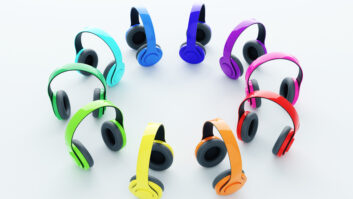(click thumbnail)Mackie recently introduced the HR624 active studio monitor, aimed toward professional broadcasters and studio engineers.
This high-resolution monitor carries a Lucasfilm THX pm3 certification and boasts a 6.7-inch die-cast magnesium frame woofer, time-aligned with a 1-inch viscous edge-damped aluminum-alloy dome tweeter. Both are mounted within a massive, acoustically nonresonant die-cast zinc exponential waveguide, along with a 6-inch by 9-inch elliptical flat piston rear-firing mass-loaded passive radiator.
The unit is lined with internal open-cell adiabatic “foam fill” acoustical damping material and finished with a 1-inch thick radius-edged MDF construction front panel.
Adiabatic means “no loss or gain of heat.” In this case, it is a material that remains thermally neutral.
A modified Linkwitz-Riley crossover-fed biamped monolithic IC provides the power to drive the two-way active monitor system. The IC is kept cool by convection. Low-frequency rolloff is provided by a sixth-order Butterworth system.
Familiar territory
In addition to the amazing number of mysterious hyphenated-name components this system sports, it has a bunch of useful, familiar and flexible features.
I will start with connectivity: balanced XLR, 1/4-inch phone and unbalanced RCA jacks face downward, permitting flushmounting the unit to the wall. Power is via ungrounded AC.
Rear-mounted easy-access controls include input sensitivity and a smart power mode selector that puts the speakers in Standby mode after eight minutes of silence.
Product CapsuleThumbs Up
THX pm3 certified
Flexible connectivity; rear-mounted easy-access controls
Acoustic Space switch helpful when ideal placement is not possible
Thumbs Down
Acoustic Switch has potential for misuse
Price: $649 each
For more information from Mackie, contact the company in Washington state at (425) 487-4333 or visit www.mackie.com
The 100-watt low-frequency and 40-watt high-frequency amplifiers mute briefly upon startup while the power supply and internal circuitry stabilize.
A thermal switch puts the speakers in standby if the heat sinks get too hot, then automatically resets to On when temperatures allow.
An overload compressor protects speakers from overload damage. An overload indicator is located on the faceplate. The unit itself is attractive; a black oak veneer over medium density fiberboard (MDF) wood, with an internal brace to increase the strength and rigidity of the box, which measures 8.25 inches by 13 inches and weighs 25 pounds.
A nice surprise was the excellent owner’s manual, which includes sound advice.
Unfamiliar territory
Then there are the unusual features.
A three-position switch, called “Acoustic Space,” reduces the low-frequency response of the HR624 to compensate for their placement in the room.
If you place the speakers against a wall you are instructed to set the Acoustic Space switch to position B. If the monitors are set into the corners of your room, set the Acoustic Space switch to A. If the monitors are freestanding – away from walls and corners – set the switch to C.
This is considerate of Mackie, as some users may not have the luxury of situating their console some distance from the front wall. Personally, I would design an appropriate listening environment and keep the speakers set to C (normal).
Additionally, given that Mackie sought THX certification, it appears these monitors are intended for use in professional applications, which suggests critical placement. With that in mind, I think this Acoustic Space switch is potentially dangerous.
Imagine recording a live event in Dolby 5.1 and in post-production discovering one channel is oddly out of character with the other four. Inspecting your recording setup, you discover someone changed one of the HR624s to a different position than the other(s). You could get pretty upset pretty quickly.
There are two other contouring controls (80 Hz and 49 Hz low-frequency filter, ±2 dB high-frequency filter), which are easy to grab. If I really needed to defeat all the engineering that went into making these speakers remarkably flat (52 Hz to 20 kHz; ±1.5 dB), I would select the combination and then cover these switches up.
Okay, enough already with the paranoia.
In session
They sound pretty good. I put them up on my peek-over-the-console stands beside a pair of Genelec 1031A nearfields and did some fundamental testing.
Making sure all switches were set to Normal and Bypass, I reproduced a series of test tones. The Mackie HR624s were astonishing on high frequencies, keeping up beautifully with the Genelecs. The rear-firing passive radiator kept the lows solid down to 50 Hz. A low-to-high sweep tone demonstrated smoothness throughout the speakers’ range.
Instrument tracks revealed some differences between brands, though. On saxophone, clarity was noticeably increased over the Genelecs, vocals as well. While this made the music sound wonderful on the HR624 speakers, I was concerned that a mix might not travel well to other speakers.
I put up a DASH multitrack tape of a project I am currently producing and mixed down two tunes – one primarily vocal/acoustic/piano/bass/drums/guitars, the other a big production with every single sound we could think of.
The drum EQ came into focus quickly, piano and supporting instruments sounding three-dimensional in the wide sweet spot these monitors provide. While I personally prefer my mix monitors to possess a tight center, allowing me extremely critical placement of instruments, for pure listening pleasure these HR624s are great.
Big easy
On the big production number, I had no difficulty getting each component to work tonally with the others; the speakers had no noticeable hole in their frequency response. Again, I noticed a distinct clarity in the Mackies that was absent in the Genelecs. Additionally, there is a midrange presence that made my mixes sound very much in my face, almost compressed. My mix sounded bigger in the Mackies. This made me nervous. I packed them up and took them home.
I set the HR624s on top of my Event 20/20bas speakers and had some fun. I listened to Bonnie Raitt’s new Tchad Blake recording “Silver Lining,” Kid A’s “Radio Head,” and “Bangra Beatz” (Indian club music) on both systems.
The Mackie HR624 monitors were simply marvelous for casual listening. Smooth, big and bright yet not edgy. When I switched to the Events, I again noticed a diminished size, however this time the brightness content between the two systems remained similar, suggesting a fundamentally different goal than Genelec.
The songs mixed on the Mackies and played back on the Events demonstrated thinness in the midrange, meaning I had EQ’d too much midrange out during the mix.
Though the Audio Precision printout that accompanies the Mackie HR624s shows a flat frequency response from 50 Hz to 20 kHz, there really is a midrange presence that makes the music presentation big, bright and impressive without being tubby – how’d they do that?
This is the first time in my whole career I have ever complained about a speaker sounding too good.
With the introduction of the HR624 self-powered biamplified two-way speaker system, Mackie adds to its history of innovative designs and quality products, giving us exquisite new tools with which to express ourselves. Thank you, Mackie.








